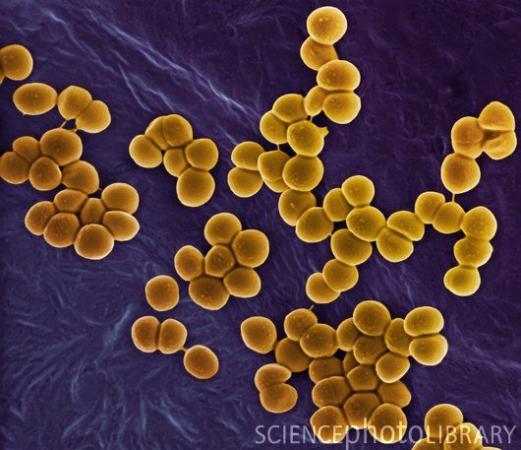一项研究报告说,两种基因可能有助于一种金黄色葡萄球菌菌株导致了20世纪50年代晚期的全世界范围的大流行,而这些基因的变化可能把当代的耐甲氧西林金黄色葡萄球菌(MRSA)主要限制在了卫生保健环境中。

金黄色葡萄球菌(扫描电镜下)
Frank R. DeLeo及其同事对8种金黄色葡萄球菌的临床分离菌株的基因组进行了测序,其中包括了大流行菌株以及当代的耐甲氧西林金黄色葡萄球菌(MRSA)克隆,然后与比较了它们之间以及参考菌株的基因组。
研究人员发现了为对于金黄色葡萄球菌毒力有重要作用的两个基因的单核苷酸变化(这称为单核苷酸多态,NPs)。这两个基因分别是附属基因调节子C(agrC)和α溶血素(hla)基因。
他们测试了172个临床分离株,然后发现了这些单核苷酸多态(SNPs)存在于大多数现代克隆中,它们会导致 agrC和hla的缺陷,有可能改变毒力和宿主-病原体相互作用。
与拥有这些单核苷酸多态(SNPs)的当代分离株相比,缺乏agrC和hla的大流行毒株和另一种耐甲氧西林金黄色葡萄球菌(MRSA)毒株能显著减少被感染小鼠的存活期。
附属基因调节子C(agrC)和α溶血素(hla)带来的毒力增加可能有助于金黄色葡萄球菌导致了20世纪50年代的大流行,而当代耐甲氧西林金黄色葡萄球菌(MRSA)菌株的关键单核苷酸多态(SNPs)可能把它们限制在了医院环境中,在那里,宿主容易感染这种菌株。
相关英文论文摘要:
Molecular differentiation of historic phage-type 80/81 and contemporary epidemic Staphylococcus aureus
Staphylococcus aureus is a bacterial pathogen known to cause infections in epidemic waves. One such epidemic was caused by a clone known as phage-type 80/81, a penicillin-resistant strain that rose to world prominence in the late 1950s. The molecular underpinnings of the phage-type 80/81 outbreak have remained unknown for decades, nor is it understood why related S. aureus clones became epidemic in hospitals in the early 1990s. To better understand the molecular basis of these epidemics, we sequenced the genomes of eight S. aureus clinical isolates representative of the phage-type 80/81 clone, the Southwest Pacific clone [a community-associated methicillin-resistant S. aureus (MRSA) clone], and contemporary S. aureus clones, all of which are genetically related and belong to the same clonal complex (CC30). Genome sequence analysis revealed that there was coincident divergence of these clones from a recent common ancestor, a finding that resolves controversy about the evolutionary history of the lineage. Notably, we identified nonsynonymous SNPs in genes encoding accessory gene regulator C (agrC) and α-hemolysin (hla)—molecules important for S. aureus virulence—that were present in virtually all contemporary CC30 hospital isolates tested. Compared with the phage-type 80/81 and Southwest Pacific clones, contemporary CC30 hospital isolates had reduced virulence in mouse infection models, the result of SNPs in agrC and hla. We conclude that agr and hla (along with penicillin resistance) were essential for world dominance of phage-type 80/81 S. aureus, whereas key SNPs in contemporary CC30 clones restrict these pathogens to hospital settings in which the host is typically compromised.
英文论文链接:https://www.pnas.org/content/early/2011/10/18/1115249108.abstract







